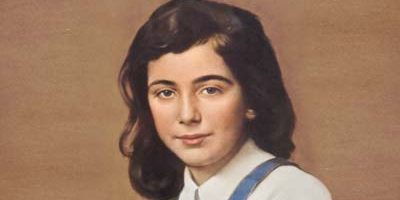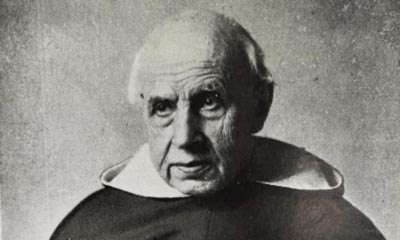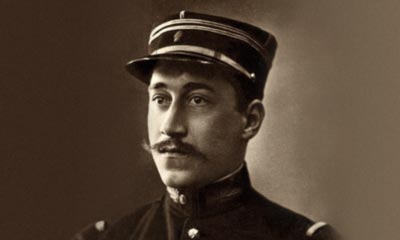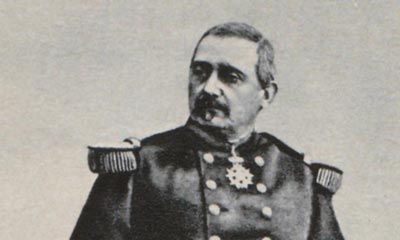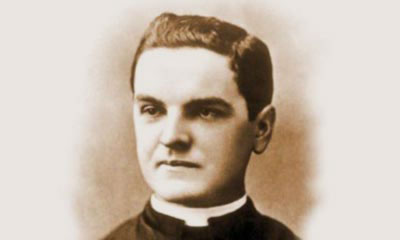December 7, 2022
Blessed Laura Vicuña
Dear Friends,
“Down the centuries, up to our own times, there are many boys and girls among those declared by the Church to be saints or blessed. … The Redeemer of humanity seems to share with them his concern for others: for parents, for other boys and girls. He eagerly awaits their prayers. What enormous power the prayer of children has! This becomes a model for grown-ups themselves: praying with simple and complete trust means praying as children pray,” wrote Pope John Paul II (Letter to Children, December 14, 1994).
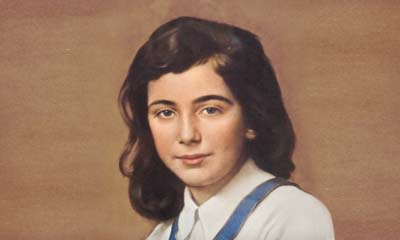 South America has bestowed upon the Church a child who was declared Blessed by the same Pope. Laura del Carmen was born on April 5, 1891 in Santiago de Chile, to José Domingo Vicuña, a military officer hailing from one of Chile’s most prominent families, and Mercedes Pino, of humble extraction. Laura was baptized nearly three weeks after her birth. That same year, serious social unrest endangered José Domingo’s parentage, and he and his family were forced to flee. They settled in Temuco, 310 miles (500 km) south of the capital, where they lived in great poverty. In 1894, a second daughter, Julia Amanda, was born, but José Domingo died a few months later. His young widow courageously took up her profession as a seamstress and eventually managed to open a small notions store. Laura proved to be a quiet and obedient child: her mother would later testify that her daughter never caused her grief.
South America has bestowed upon the Church a child who was declared Blessed by the same Pope. Laura del Carmen was born on April 5, 1891 in Santiago de Chile, to José Domingo Vicuña, a military officer hailing from one of Chile’s most prominent families, and Mercedes Pino, of humble extraction. Laura was baptized nearly three weeks after her birth. That same year, serious social unrest endangered José Domingo’s parentage, and he and his family were forced to flee. They settled in Temuco, 310 miles (500 km) south of the capital, where they lived in great poverty. In 1894, a second daughter, Julia Amanda, was born, but José Domingo died a few months later. His young widow courageously took up her profession as a seamstress and eventually managed to open a small notions store. Laura proved to be a quiet and obedient child: her mother would later testify that her daughter never caused her grief.
In 1898, Mercedes met a group of Sisters from the Salesian congregation of Mary Help of Christians, led by Father Milanesio, an intrepid missionary. They wished to go to Argentina, but rain and heavy snowfall in the Andes had trapped them in Temuco. In January 1899, leaving Mercedes and her daughters behind, the sisters set off for the mountains, arriving a few days later at Junín de los Andes, in the Argentine province of Neuquén. A military post, Junín is located at an altitude of 3000 ft (900 m) in the foothills of the Andes. At the time, it had a population of three hundred and fifty, while another two thousand inhabitants, mostly indigenous and Chilean, were scattered in the surrounding altiplanos (highlands) and valleys. The first settlers in the area had only arrived some twenty years earlier. The spiritual conquest of the area had only just begun: the first Salesian mission was established in 1888. Don Milanesio was one of the daring missionaries who made the rounds of the region on horseback, baptizing hundreds, if not thousands, of Arauncans (Indians from southern Chile and Argentina). The Daughters of Mary Help of Christians opened the first girls’ school in the region on March 6, 1899. A school for boys was also opened by the Salesian Fathers. Fathers Augusto Crestanello and Zacarias Genghini provided spiritual direction for both these institutions.
A feudal lord… without faith
Mercedes soon realized that there was no future for her in Temuco, and decided to move elsewhere with her daughters. During the summer season, from December to March, caravans used to travel regularly from Chile to the richer neighboring Argentinian province. On her arrival in Junín, the young woman looked for a job to pay for her daughters’ education.
For five or six months, she worked as a maid on a farm, before moving on to Ñorquín, in the far north of Neuquén, and finally to Las Lajas, a place which the Salesians visited from time to time. Mercedes was anxious to find some kind of support so that she could offer her daughters a decent life and not feel so alone. That is when she met Manuel Mora, owner of the Quilquihue farm near the village of Chapelco, and of several other estates. He was a very good rider, unusually robust, and very wealthy: he was the strong man of the neighborhood. He would strut around, behaving like a feudal lord on his domain with its many servants and laborers. But woe betide anyone who dared oppose him: he would suddenly switch from his friendly and gentlemanly manners to harshness and vulgarity. The Sisters of Junín described him as a “rich cattle owner, uneducated and without faith.” All the same, Mercedes allowed herself to be won over when he asked her to come and live with him in exchange for paying for her daughters’ schooling. Don Genghini, from the Salesian mission, would later testify that at the time, 70 percent of couples were living together without any concern for civil or religious laws.
Mercedes found no joy in living with Manuel Mora, but the situation provided her with some degree of security. As a result, she even put up with the brutality of her partner. When she learned that the nuns she had known in Temuco were opening a school, she went there to enroll her daughters. Laura was very happy at the school, which she called “my paradise;” as for the Sisters, they valued her piety, her fraternal charity and her faithfulness to her daily duties. She was cheerful and always tried to help those in need. This was a relief to Mercedes. Later, Laura would say: “The Child Jesus must have been happy with my mother’s resolution, and so was I.” The enrollment form reads: “Junín, January 21, 1900. Julia Amanda Vicuña, six years old, Laura del Carmen Vicuña, nine years old; Chilean; parents: Domingo and Mercedes Pino, Chilean. Paying fifteen pesos a month each.” The school’s pupils were young girls who were quicker to seize horses’ reins than a pen or a needle.
“My best prayer”
The headmistress, Mother Piai, would later testify: “From her very first days at the school, Laura was noted for having judgment beyond her years, and a true inclination to piety. Although she was only a little girl, her devotion was earnest, without false pretense or exaggeration of any kind.” While waiting for the school year to begin on April 1, the Vicuña sisters lived with the nuns. “Realizing at once that I had before me such an exceptional creature,” wrote Mother Piai, “I almost had a feeling of fear, and I wondered if I were not in danger of ruining the Lord’s work in her. For this reason, I entrusted her particularly to Don Crestanello, who, even more than I, must have had an immediate intuition of the richness of this angelic soul, since he did not limit himself to admiring its beauty, but instructed Laura for four years with spiritual wisdom and Salesian fatherliness.” Laura herself said: “For me, praying or working is the same thing, praying or playing, praying or sleeping. By doing what I am asked to do, I am doing what God wants me to do, and that is what I want to do; that is my best prayer.” She attained such a high and continuous degree of prayer, her headmistress would testify, that she could sometimes be seen to be absorbed in God even at recess. “It seems to me,” said Laura, “that it is God himself who sustains in me the remembrance of his divine Presence. Wherever I am, whether in the classroom or in the yard, this remembrance accompanies me, helps me and consoles me.”
However, her mother’s marital situation caused the child to suffer deeply. “I remember that the first time I explained the sacrament of marriage,” one of the sisters recalled, “Laura fainted, probably because she understood from my words that her mother would remain in a state of mortal sin as long as she stayed with this gentleman… I spoke to the headmistress about it, and she told me to bring up the subject again to see if Laura was really suffering because of the situation and was aware of it. Which I did. Again, she turned pale, and I had to rush to her aid.” From then on, Laura began to pray and do penance to obtain her mother’s return to God, and her separation from Manuel. During the process for her sister’s beatification, Julia Amanda later recounted: “She used to invite me to pray, especially for my mother; I didn’t know the reasons for this at the time, but I knew later that she did it to obtain her return to the straight path.”
Good intention is not enough
Laura’s pure heart recognized the danger that threatened her mother, for it is never permissible to do evil, even for the sake of good (cf. Rom 3:8). Poverty and concern for the future of her daughters surely constituted extenuating circumstances for Mercedes; however, the Catechism of the Catholic Church teaches: “A good intention (for example, that of helping one’s neighbor) does not make behavior that is intrinsically disordered, such as lying and calumny, good or just. The end does not justify the means… Circumstances of themselves cannot change the moral quality of acts themselves; they can make neither good nor right an action that is in itself evil.” (CCC, nos. 1753-1754). St John Paul II clarifies this principle as follows: “Saint Paul declares that ‘the immoral, idolaters, adulterers’ are excluded from the Kingdom of God (cf. 1 Cor 6:9)… The reason is this: the commandment of love of God and neighbor does not have in its dynamic any higher limit, but it does have a lower limit, beneath which the commandment is broken… The Church has always taught that one may never choose kinds of behavior prohibited by the moral commandments expressed in negative form in the Old and New Testaments… Mortal sin exists when a person knowingly and willingly, for whatever reason, chooses something gravely disordered. In fact, such a choice already includes contempt for the divine law, a rejection of God’s love for humanity and the whole of creation: the person turns away from God and loses charity.” (Encyclical Veritatis Splendor, August 6, 1993, nos. 49, 52, 70).
At the end of the year 1900, the students separated as the girls went to their own homes for the holidays. For Laura, being away from the school where she attended Mass daily, prayed the Rosary with all her fellow pupils and the Sisters, went to confession often, and benefited from the wise advice of Father Crestanello, was a genuine sacrifice. Her return to school in March 1901 was accordingly a time of celebration for her. When her confessor told her that she would be admitted that year to make her First Holy Communion, she shed tears of joy. This first encounter with Jesus in the Eucharist took place on June 2, 1901; Laura was ten years old. Her confessor wrote: “She had always been obedient, submissive, humble and kind, but from that day onwards it was noticeable that she put a greater perfection into all things, and greater recollection and fervor in her devotional practices. Laura herself would later explain: “What delicious moments! United with Jesus, I spoke to Him about everyone, and for everyone I asked for graces and favors!” Father Crestanello commented: “One can hope for great things from a child who receives First Communion well.” Following the example of St Dominic Savio, who was offered as a model in Salesian schools, Laura wrote three resolutions in her own handwriting: “1. I want, my Jesus, to love Thee and serve Thee throughout my life; for this I offer Thee my whole soul, my whole heart and my whole being. 2. I would rather die than offend Thee by sin; therefore, I want to keep away from everything that could separate me from Thee. 3. I promise to do everything possible, even great sacrifices, so that Thou mayest be known and loved more and more, and to make reparation for the offenses which men who do not love Thee inflict on Thee every day, especially those which Thou receives from those who are close to me. O my God, grant me a life of love, mortification and sacrifice!” The only sorrow that overshadowed that day was that her mother did not receive Communion with her.
A source of strength
“There is no doubt that an unforgettable meeting with Jesus is First Holy Communion, a day to be remembered as one of life’s most beautiful. The Eucharist, instituted by Christ at the Last Supper, on the night before his Passion, is a Sacrament of the New Covenant, rather, the greatest of the Sacraments. In this Sacrament, the Lord becomes food for the soul under the appearances of bread and wine. Children receive this Sacrament solemnly a first time—in First Holy Communion—and are encouraged to receive it afterwards as often as possible in order to remain in close friendship with Jesus. (…) For how many children in the history of the Church has the Eucharist been a source of spiritual strength, sometimes even heroic strength!” (John Paul II, Letter to Children, November 21, 1994).
While on holiday, Laura was violently attacked by Manuel Mora. He was attracted by her budding beauty, and attempted to seduce her. Her fierce refusal led him to tell Mercedes that he would no longer pay for her daughters’ schooling. The school authorities allowed Laura and Julia Amanda to continue their studies without payment. Yet Laura suffered from the fact that her mother’s situation had become even worse, and she blamed herself for failing to help. The school year of 1902 began on March 1 with preparations for the mission that the Salesian Bishop Cagliero, Vicar Apostolic for Northern Patagonia, was to preach in Junín. It opened on March 25, on Ash Wednesday. Doña Mercedes came to the mission for a few days because her two daughters were to receive Confirmation on March 29. According to the missionaries, “the most striking wonder of grace during the mission was the great number of marriages that we were able to bless and legitimize”. But Mercedes did not avail herself of this opportunity.
Laura conceived in her heart the desire to remain forever with the Sisters, and she asked her director for the favor of being admitted as an aspirant to the Daughters of Mary Help of Christians. He refused. Her friend Francisca Mendoza later explained: “She told me that she wanted to enter the Institute of the Daughters of Mary Help of Christians and take her vows, and that she was very sorry not to be able to do so, because she did not have the necessary documents; she asked me to help her by praying for her.” The truth of the matter was that Doña Mercedes’ adultery had raised doubts about the legitimacy of Laura’s birth, and the Constitutions of the Daughters of Mary Help of Christians were very strict on this point. It was not until many years later—in 1943—that her certificate of baptism was found, and all doubts were dispelled. Laura was not discouraged, however, and, prepared by her confessor, she took private vows in May 1902. That year, while continuing to follow her own classes, Laura helped the younger pupils to dress, comb their hair, make their beds, and keep clean and cheerful. Thus, did she repay her debt of gratitude to the school which received her free of charge. “She behaved like a mother to the children,” said Francisca Mendoza. A former companion added: “In the two years that I was with her, I never saw her show signs of ill-will or repugnance, as will happen with those who render services.”
“May my mother be saved!”
Shortly after the mission at Junín de los Andes and its obvious fruits of conversion, seeing that her mother had not abandoned her disordered life, Laura made a decision of heroic charity that stands out as the hallmark of her brief existence: to offer herself to God as a victim for her mother’s conversion. She remembered Jesus’ words: Greater love than this no man hath, that a man lay down his life for his friends (Jn 15:13). “Her confidence in the protection of Mary and in the goodness of the divine Heart,” her confessor later commented, “encouraged her to insist in her request and, having nothing else to offer to obtain this grace, she decided to offer her very life, and to accept death willingly in exchange for this much desired conversion.” She begged the priest to allow her to perform this heroic act and to bless her ardent desire. After a moment’s hesitation and in view of her insistence, he granted her permission, seeing in her determination the manifest action of the Holy Spirit. Laura immediately ran to throw herself at the Lord’s feet and, shedding tears of joy in the hope of being heard, offered herself as a holocaust to Jesus and to Mary. A few months later, she fell ill: “Lord, may I suffer whatever you deem fit, but may my mother be converted and saved!”
On December 8, 1902, Laura was admitted to the Daughters of Mary. Dressed in white, with a blue sash, the aspirant approached the priest who bestowed upon this new Daughter of Mary her ribbon, medal and handbook, saying: “Receive this ribbon and medal as the insignia of Mary Immaculate and the outward sign of your consecration to this sweet Mother. Remember that while wearing them, you must show yourself to be her worthy daughter by your innocent and holy life.” Julia Amanda later recalled: “The day Laura received the Daughter of Mary ribbon was one of the happiest of her life!” On May 14, 1910, Felix Ortiz, a Salesian seminarian, testified in the Viedma newspaper: “I too went to visit her… Approaching her bed, I asked her what made her happiest at that moment. Smiling, she murmured, almost in my ear: ‘What comforts me most at this moment is that I have always been devoted to Mary. Oh yes, she is my Mother, she is my Mother! Nothing makes me happier than to think that I am a Daughter of Mary!’” Sister María Rodríguez confirmed this testimony, saying: “Laura had a great devotion to the Virgin, especially Our Lady of Carmel, like all good Chileans.”
“Tomorrow I will go to confession!”
In mid-January 1904, Laura went to confession for the last time, and then received Holy Communion. She felt that her end was near. When she heard that Mother Piai, Sister Azocar and Father Crestanello would be leaving for Chile, she sighed: “My God, I will have to die without having around me any of those who can help me! Ah, my Jesus, how hard that is! But Thy will be done!” Her confessor asked Father Genghini to assist her until her death. On January 22, at 5 o’clock in the morning, as the caravan was setting out for Temuco, Father Genghini brought her the Viaticum of Holy Communion and, in the course of the morning, administered Extreme Unction. Two of her friends were present, María and Mercedes Vera (both of whom were to become religious as Daughters of Mary Help of Christians), as well as Sister María Rodríguez, and Félix Ortiz. At 5 o’clock in the afternoon, Laura asked Father Genghini to call her mother. Mercedes, realizing that this was the end, exclaimed: “My daughter, my daughter! Are you leaving me?” Overcoming her emotion, Laura answered tremulously, but with great tenderness: “Yes, Mother, I am dying, because I asked this of Jesus myself… For almost two years I have offered my life for you, to obtain the grace of your conversion to God. Oh mother! Will I not have the joy, before I die, of seeing you repent?—My dear Laura, I swear to you at this moment that I will do what you ask of me… God be my witness, I repent!”, Doña Mercedes exclaimed, adding: “Yes, my daughter. Tomorrow morning, I will go to church with Amanda, and I will confess.” Laura was overjoyed: “Thank you Jesus, thank you Mary! Now I die happy!” After these words, she breathed her last, at six o’clock in the afternoon of January 22. She was twelve years and nine months old. “In her coffin,” Julia noted, “she was dressed as a Daughter of Mary.” On the very afternoon of Laura’s death, Doña Mercedes asked Father Genghini to tell Manuel Mora that he should forget about her, because she had decided to change her life. The priest would testify: “At Laura’s funeral Mass, Mrs. Vicuña confessed and received Holy Communion… From then on, and until she returned to Chile, I was her spiritual director.” Doña Mercedes went into hiding and then fled to Temuco. She later returned to Junín de los Andes and lived by her work until the marriage of her daughter Julia Amanda in 1906. She then moved back to Chile, remarried and lived a Christian life until her death on September 17, 1929, aged fifty-nine.
Laura was declared Blessed by Pope John Paul II on February 25, 1982. In his Letter to Children, he wrote: “Unless you turn and become like children, you will not enter the kingdom of heaven (Mt 18:3). Does not Jesus make the child a model even for adults? There is something in the child that must never fail those who want to enter the kingdom of heaven. Heaven is promised to all those who are simple like children, to all those who, like them, are filled with a spirit of pure trust and rich in goodness. Only they can find in God a Father and become in turn, thanks to Jesus, children of God” (December 13, 1994). Let us ask Blessed Laura to inspire us with great compassion for sinners and filial love for our heavenly Father!


